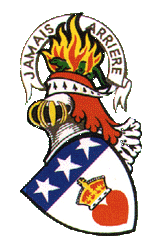Farme Castle once stood in Rutherglen, southeast of Glasgow, Scotland,
occupying a strategic position half a mile east of Farme Cross, where
the A724 and A749 roads intersect. The castle comprised a keep that
formed one corner of a courtyard, enclosed by high walls and extended by
a castellated mansion. Subsidiary buildings and an ornate arched gateway
completed the courtyard’s architecture. The keep itself, a three-storey
structure with a garret, featured a corbelled-out parapet with
machicolations and water spouts.
In 1792, renovations unveiled an
ancient wooden ceiling hidden within the castle, adorned with
inscriptions linked to the Stewarts and dated to 1325. In the 2010s, a
fragment of this historic text was recreated as part of a public art
installation at Cuningar Loop, a nearby public park.
Historically, Rutherglen was a significant stronghold during Scotland's
early history. While Glasgow was still a modest village, Rutherglen and
its castle held great importance as a base for Scottish kings. During
Edward I's occupation of Scotland, the castle was captured but later
reclaimed in 1313 by Edward Bruce, brother of Robert the Bruce. It
remained inhabited for centuries, with its later years seeing occupancy
by a branch of the Hamilton family. Over time, however, the castle fell
into disrepair, and its remnants were eventually dismantled, with
materials repurposed for mundane uses.
Architecturally, Farme
Castle was a 15th-century simple keep, likely built on older
foundations. The estate had a storied history, being granted by Robert
the Bruce to Walter The Steward before passing through the hands of the
Douglases, the Crawfords (from 1482 to 1599), and eventually the
Flemings. The estate later came under the ownership of the Earl of
Selkirk, a son of Ann, Duchess of Hamilton, and finally the Duke of
Hamilton. It was subsequently sold to the family of its last proprietor.
By the 1960s, Farme Castle had been repurposed to store redundant
mining equipment and was eventually demolished. Today, the site is home
to an industrial estate bearing the castle’s name, preserving a trace of
its historic legacy.
Contributions
Do you have an ancestor whose
story should be told here? Please let us have the details.
Source
Sources for this article include:
xxx |


